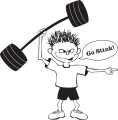Beware of out-of-work actors pitching stuff at 2 in the morning

A lot of money gets wasted on exercise equipment, but the measure of a successful purchase is if the equipment is being used and if it yields positive results.
Originally published in South Coast Today.
We are now in October, and here comes the understated commercialism of the holiday season. Workout music will soon turn to Christmas music, not to mention those incessant Hanukkah carols. The gift-giving season is upon us, and nothing says I love you like a piece of exercise equipment for that self-conscious special someone in our lives.
I’ve seen my share of would-be exercisers eternally researching fitness products for their silver bullets when they could be using that time to actually work out. But I think, on the whole, we tend to be particularly impulsive shoppers when it comes to exercise equipment.
In our culture of New Year’s resolutions and self-delusion, we’re pretty easy marks. When is a purchase a wise investment, and when is a purchase a waste of money?
There’s a lot of exercise propaganda and snake oil out there to red-flag and steer clear of. Even amongst the legitimate equipment, manufacturers often overstate the benefits. Many of the infomercials are courteous enough to provide small print disclaimers:
‒ results not typical, your results will vary.
‒ unique experience, you may be less successful.
Barely visible admissions that their ad’s representatives are not very representative.
Another common pattern of deception is when they say that a piece of equipment will burn “up to” a certain number of times more calories than other pieces of equipment. Whoever came up with this loophole should be a first ballot inductee into the huckster’s hall of fame. “Up to” is a very misleading way of expressing caloric cost because you don’t have to specify or include averages, comparable work bouts, or any valid test parameters. The unprincipled companies take advantage of this ambiguity whereas the reputable ones might use the wording “up to” in a more responsible way.
The dubious selling point that drives me crazy is when some newfangled machine offers a hybrid exercise by combining a couple of time-honored existing exercises.
The exercise itself may be commendable, but they market it as two or three separate workouts all rolled up into one. It’s implied that if a skating workout burns 500 calories and a running workout burns 500 calories, then some strange combination of the two will burn 1,000 calories. But these kind of crossbred exercises are more like the average between two exercises, not the sum total of two exercises.
If you’re walking south and you’re walking west, are you walking in two directions or are you really just walking southwest?
Out of any of the proven, valid categories of exercise equipment … it all works.
Experts and lay people may argue what’s best, but it all works.
More important than the question of “what’s best?” is the question of “what’s best for me?”
Some people just aren’t built for running. Some people with back problems should avoid forward leaning, while others with back problems should avoid backward leaning. There are so many different injuries, predispositions to injury and unique restrictions that it makes sense to ascertain your own particular concerns before buying a piece of exercise equipment.
Also consider the efficacy of an exercise or piece of exercise equipment. Using an elliptical to increase your vertical jump is not gonna get the job done. You’re barking up the wrong tree if you buy a hand gripper for weight loss. Make sure your choice of exercise is a good match for your fitness goals.
Regardless of what the exercise product is, there is the issue of engineering.
Two major areas that I like to look at are strength and precision. When assessing precision I think in terms of smooth movement. Moving parts on exercise equipment should glide evenly, not jerky. The durability of exercise equipment can be a function of several components. Obviously the materials that make up the equipment are going to be a determining factor, but there are also considerations like whether a piece of equipment is welded or held together by bolts.
There are times when you don’t need to be an expert, and kicking the tires is enough. When it’s a substantial investment, though, you might want to consult a specialty fitness dealer. They should be able to guide you through the nitty-gritty of exercise equipment, such as motors and electronics, when sizing up the different models.
Their knowledge of the different manufacturers also becomes important when having to deal with the issue of recourse. Warranties and money back is one thing, but replacement parts for normal wear and tear is another benefit of dealing with a proven manufacturer. You want an industry expert, not a salesperson.
There’s a time to skimp and a time to spend. If you’re going to use your treadmill for laundry storage, go to Ikea, but if its going to be seeing 35-40 miles of use per week, go to a specialty store. The equipment in a varsity weight room must withstand abuse, but a home gym doesn’t necessarily require commercial durability.
We’re living in the computer age, and how antiquated it must seem to use our own bodies and surroundings to create exercise. There have been some really good design improvements in the manufacturing of exercise equipment. Some things are safer and more comfortable, and moving parts operate with a higher degree of precision. But it’s hard to say whether the exercise value has gone up.
Today’s gym rats and exercise enthusiasts have nothing on yesterday’s lumberjacks and pioneer women. We don’t need technology for exercise, but anything that helps the cause is a good purchase. If it works, and you actually use it, you’re on the right track.

Norm Meltzer aka The Muscle-less Wonder
